Mechanisms of Evolution
Mechanisms: the processes of evolution
Evolution is the process by which modern organisms have descended from ancient ancestors. Evolution is responsible for both the remarkable similarities we see across all life and the amazing diversity of that life — but exactly how does it work?
Fundamental to the process is genetic variation upon which selective forces can act in order for evolution to occur. This section examines the mechanisms of evolution focusing on:
Descent and the genetic differences that are heritable and passed on to the next generation;
Mutation, migration (gene flow), genetic drift, and natural selection as mechanisms of change;
The importance of genetic variation;
The random nature of genetic drift and the effects of a reduction in genetic variation;
How variation, differential reproduction, and heredity result in evolution by natural selection; and
How different species can affect each other’s evolution through coevolution.
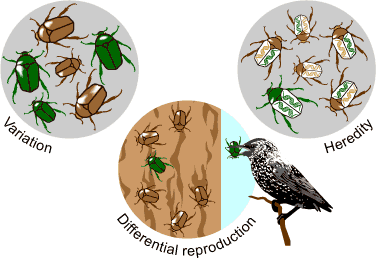
Descent with modification
We’ve defined evolution as descent with modification from a common ancestor, but exactly what has been modified? Evolution only occurs when there is a change in gene frequency within a population over time. These genetic differences are heritable and can be passed on to the next generation — which is what really matters in evolution: long term change.
Compare these two examples of change in beetle populations. Which one is an example of evolution?
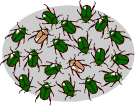 1. Beetles on a diet
1. Beetles on a diet
Imagine a year or two of drought in which there are few plants that these beetles can eat.
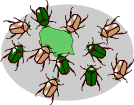 All the beetles have the same chances of survival and reproduction, but because of food restrictions, the beetles in the population are a little smaller than the preceding generation of beetles.
All the beetles have the same chances of survival and reproduction, but because of food restrictions, the beetles in the population are a little smaller than the preceding generation of beetles.
2. Beetles of a different color
 Most of the beetles in the population (say 90%) have the genes for bright green coloration and a few of them (10%) have a gene that makes them more brown.
Most of the beetles in the population (say 90%) have the genes for bright green coloration and a few of them (10%) have a gene that makes them more brown.
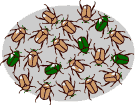 Some number of generations later, things have changed: brown beetles are more common than they used to be and make up 70% of the population.
Some number of generations later, things have changed: brown beetles are more common than they used to be and make up 70% of the population.
Which example illustrates descent with modification — a change in gene frequency over time?
The difference in weight in example 1 came about because of environmental influences — the low food supply — not because of a change in the frequency of genes. Therefore, example 1 is not evolution. Because the small body size in this population was not genetically determined, this generation of small-bodied beetles will produce beetles that will grow to normal size if they have a normal food supply.
The changing color in example 2 is definitely evolution: these two generations of the same population are genetically different. But how did it happen?
Mechanisms of change
Each of these four processes is a basic mechanism of evolutionary change.
Mutation
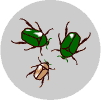 A mutation could cause parents with genes for bright green coloration to have offspring with a gene for brown coloration. That would make genes for brown coloration more frequent in the population than they were before the mutation.
A mutation could cause parents with genes for bright green coloration to have offspring with a gene for brown coloration. That would make genes for brown coloration more frequent in the population than they were before the mutation.
Migration
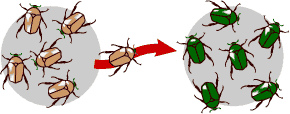 Some individuals from a population of brown beetles might have joined a population of green beetles. That would make genes for brown coloration more frequent in the green beetle population than they were before the brown beetles migrated into it.
Some individuals from a population of brown beetles might have joined a population of green beetles. That would make genes for brown coloration more frequent in the green beetle population than they were before the brown beetles migrated into it.
Genetic drift
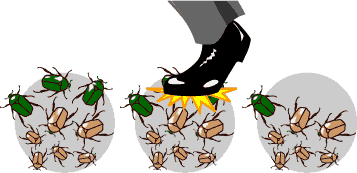 Imagine that in one generation, two brown beetles happened to have four offspring survive to reproduce. Several green beetles were killed when someone stepped on them and had no offspring. The next generation would have a few more brown beetles than the previous generation — but just by chance. These chance changes from generation to generation are known as genetic drift.
Imagine that in one generation, two brown beetles happened to have four offspring survive to reproduce. Several green beetles were killed when someone stepped on them and had no offspring. The next generation would have a few more brown beetles than the previous generation — but just by chance. These chance changes from generation to generation are known as genetic drift.
Natural selection
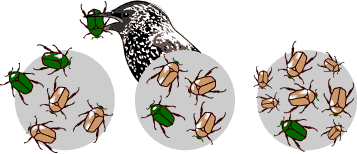 Imagine that green beetles are easier for birds to spot (and hence, eat). Brown beetles are a little more likely to survive to produce offspring. They pass their genes for brown coloration on to their offspring. So in the next generation, brown beetles are more common than in the previous generation.
Imagine that green beetles are easier for birds to spot (and hence, eat). Brown beetles are a little more likely to survive to produce offspring. They pass their genes for brown coloration on to their offspring. So in the next generation, brown beetles are more common than in the previous generation.
All of these mechanisms can cause changes in the frequencies of genes in populations, and so all of them are mechanisms of evolutionary change. However, natural selection and genetic drift cannot operate unless there is genetic variation — that is, unless some individuals are genetically different from others. If the population of beetles were 100% green, selection and drift would not have any effect because their genetic make-up could not change.
So, what are the sources of genetic variation?
Genetic variation
Without genetic variation, some of the basic mechanisms of evolutionary change cannot operate.
There are three primary sources of genetic variation, which we will learn more about:
- Mutations are changes in the DNA. A single mutation can have a large effect, but in many cases, evolutionary change is based on the accumulation of many mutations.
- Gene flow is any movement of genes from one population to another and is an important source of genetic variation.
- Sex can introduce new gene combinations into a population. This genetic shuffling is another important source of genetic variation.

Mutations
Mutation is a change in DNA, the hereditary material of life. An organism’s DNA affects how it looks, how it behaves, and its physiology — all aspects of its life. So a change in an organism’s DNA can cause changes in all aspects of its life.
Mutations are random
Mutations can be beneficial, neutral, or harmful for the organism, but mutations do not “try” to supply what the organism “needs.” In this respect, mutations are random — whether a particular mutation happens or not is unrelated to how useful that mutation would be.
Not all mutations matter to evolution
Since all cells in our body contain DNA, there are lots of places for mutations to occur; however, not all mutations matter for evolution. Somatic mutations occur in non-reproductive cells and won’t be passed onto offspring.
 For example, the golden color on half of this Red Delicious apple was caused by a somatic mutation. The seeds of this apple do not carry the mutation.
For example, the golden color on half of this Red Delicious apple was caused by a somatic mutation. The seeds of this apple do not carry the mutation.
The only mutations that matter to large-scale evolution are those that can be passed on to offspring. These occur in reproductive cells like eggs and sperm and are called germ line mutations.
A single germ line mutation can have a range of effects:
- No change occurs in phenotype
Some mutations don’t have any noticeable effect on the phenotype of an organism. This can happen in many situations: perhaps the mutation occurs in a stretch of DNA with no function, or perhaps the mutation occurs in a protein-coding region, but ends up not affecting the amino acid sequence of the protein. 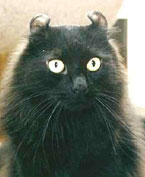 Small change occurs in phenotype
Small change occurs in phenotype
A single mutation caused this cat’s ears to curl backwards slightly.- Big change occurs in phenotype
Some really important phenotypic changes, like DDT resistance in insects are sometimes caused by single mutations. A single mutation can also have strong negative effects for the organism. Mutations that cause the death of an organism are called lethals — and it doesn’t get more negative than that.
There are some sorts of changes that a single mutation, or even a lot of mutations, could not cause. Neither mutations nor wishful thinking will make pigs have wings; only pop culture could have created Teenage Mutant Ninja Turtles — mutations could not have done it.
The causes of mutations
Mutations happen for several reasons.
- DNA fails to copy accurately
Most of the mutations that we think matter to evolution are “naturally-occurring.” For example, when a cell divides, it makes a copy of its DNA — and sometimes the copy is not quite perfect. That small difference from the original DNA sequence is a mutation.
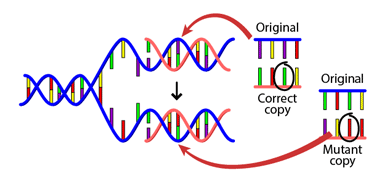
- External influences can create mutations
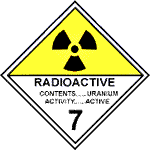
Mutations can also be caused by exposure to specific chemicals or radiation. These agents cause the DNA to break down. This is not necessarily unnatural — even in the most isolated and pristine environments, DNA breaks down. Nevertheless, when the cell repairs the DNA, it might not do a perfect job of the repair. So the cell would end up with DNA slightly different than the original DNA and hence, a mutation.
Gene flow
Gene flow — also called migration — is any movement of individuals, and/or the genetic material they carry, from one population to another. Gene flow includes lots of different kinds of events, such as pollen being blown to a new destination or people moving to new cities or countries. If gene versions are carried to a population where those gene versions previously did not exist, gene flow can be a very important source of genetic variation. In the graphic below, the gene version for brown coloration moves from one population to another.
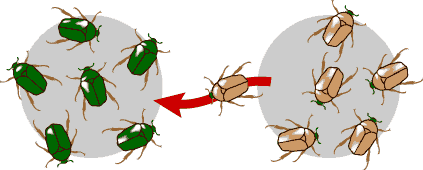
Sex and genetic shuffling
Sex can introduce new gene combinations into a population and is an important source of genetic variation.
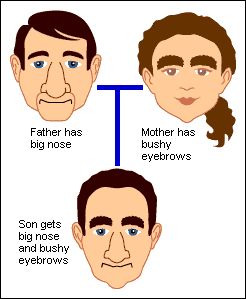 You probably know from experience that siblings are not genetically identical to their parents or to each other (except, of course, for identical twins). That’s because when organisms reproduce sexually, some genetic “shuffling” occurs, bringing together new combinations of genes. For example, you might have bushy eyebrows and a big nose since your mom had genes associated with bushy eyebrows and your dad had genes associated with a big nose. These combinations can be good, bad, or neutral. If your spouse is wild about the bushy eyebrows/big nose combination, you were lucky and hit on a winning combination!
You probably know from experience that siblings are not genetically identical to their parents or to each other (except, of course, for identical twins). That’s because when organisms reproduce sexually, some genetic “shuffling” occurs, bringing together new combinations of genes. For example, you might have bushy eyebrows and a big nose since your mom had genes associated with bushy eyebrows and your dad had genes associated with a big nose. These combinations can be good, bad, or neutral. If your spouse is wild about the bushy eyebrows/big nose combination, you were lucky and hit on a winning combination!
This shuffling is important for evolution because it can introduce new combinations of genes every generation. However, it can also break up “good” combinations of genes.
Development
Development is the process through which an embryo becomes an adult organism and eventually dies. Through development, an organism’s genotype is expressed as a phenotype, exposing genes to the action of natural selection.
Studies of development are important to evolutionary biology for several reasons:
Explaining major evolutionary change
Changes in the genes controlling development can have major effects on the morphology of the adult organism. Because these effects are so significant, scientists suspect that changes in developmental genes have helped bring about large-scale evolutionary transformations. Developmental changes may help explain, for example, how some hoofed mammals evolved into ocean-dwellers, how water plants invaded the land, and how small, armored invertebrates evolved wings.
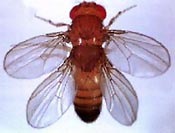 |
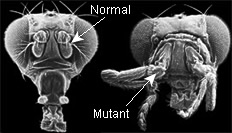 |
Learning about evolutionary history
An organism’s development may contain clues about its history that biologists can use to build evolutionary trees.

Limiting evolutionary change
Developmental processes may constrain evolution, preventing certain characters from evolving in certain lineages. For example, development may help explain why there are no truly six-fingered tetrapods.
Genetic drift
Genetic drift — along with natural selection, mutation, and migration — is one of the basic mechanisms of evolution.
In each generation, some individuals may, just by chance, leave behind a few more descendents (and genes, of course!) than other individuals. The genes of the next generation will be the genes of the “lucky” individuals, not necessarily the healthier or “better” individuals. That, in a nutshell, is genetic drift. It happens to ALL populations — there’s no avoiding the vagaries of chance.
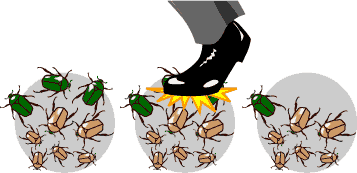
Earlier we used this hypothetical cartoon. Genetic drift affects the genetic makeup of the population but, unlike natural selection, through an entirely random process. So although genetic drift is a mechanism of evolution, it doesn’t work to produce adaptations.
Natural selection is one of the basic mechanisms of evolution, along with mutation, migration, and genetic drift.
Darwin’s grand idea of evolution by natural selection is relatively simple but often misunderstood. To find out how it works, imagine a population of beetles:
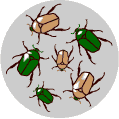 There is variation in traits.
There is variation in traits.
For example, some beetles are green and some are brown.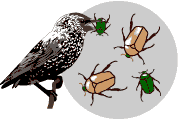 There is differential reproduction.
There is differential reproduction.
Since the environment can’t support unlimited population growth, not all individuals get to reproduce to their full potential. In this example, green beetles tend to get eaten by birds and survive to reproduce less often than brown beetles do.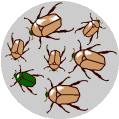 There is heredity.
There is heredity.
The surviving brown beetles have brown baby beetles because this trait has a genetic basis.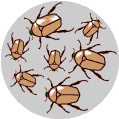 End result:
End result:
The more advantageous trait, brown coloration, which allows the beetle to have more offspring, becomes more common in the population. If this process continues, eventually, all individuals in the population will be brown.
If you have variation, differential reproduction, and heredity, you will have evolution by natural selection as an outcome. It is as simple as that.
Natural selection at work
Scientists have worked out many examples of natural selection, one of the basic mechanisms of evolution.
Any coffee table book about natural history will overwhelm you with full-page glossies depicting amazing adaptations produced by natural selection, such as the examples below.
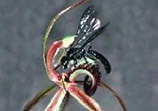 |
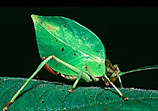 |
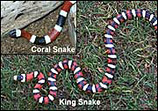 |
 Behavior can also be shaped by natural selection. Behaviors such as birds’ mating rituals, bees’ wiggle dance, and humans’ capacity to learn language also have genetic components and are subject to natural selection. The male blue-footed booby, shown to the right, exaggerates his foot movements to attract a mate.
Behavior can also be shaped by natural selection. Behaviors such as birds’ mating rituals, bees’ wiggle dance, and humans’ capacity to learn language also have genetic components and are subject to natural selection. The male blue-footed booby, shown to the right, exaggerates his foot movements to attract a mate.
In some cases, we can directly observe natural selection. Very convincing data show that the shape of finches’ beaks on the Galapagos Islands has tracked weather patterns: after droughts, the finch population has deeper, stronger beaks that let them eat tougher seeds.
In other cases, human activity has led to environmental changes that have caused populations to evolve through natural selection. A striking example is that of the population of dark moths in the 19th century in England, which rose and fell in parallel to industrial pollution. These changes can often be observed and documented.
What about fitness?
Biologists use the word fitness to describe how good a particular genotype is at leaving offspring in the next generation relative to how good other genotypes are at it. So if brown beetles consistently leave more offspring than green beetles because of their color, you’d say that the brown beetles had a higher fitness.
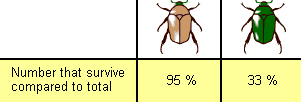
Of course, fitness is a relative thing. A genotype’s fitness depends on the environment in which the organism lives. The fittest genotype during an ice age, for example, is probably not the fittest genotype once the ice age is over.
Fitness is a handy concept because it lumps everything that matters to natural selection (survival, mate-finding, reproduction) into one idea. The fittest individual is not necessarily the strongest, fastest, or biggest. A genotype’s fitness includes its ability to survive, find a mate, produce offspring — and ultimately leave its genes in the next generation.
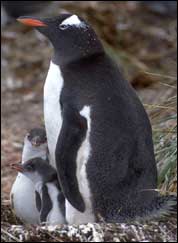 |
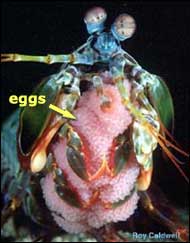 |
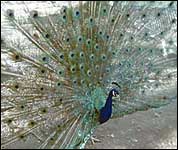 |
Caring for your offspring (above left), and producing thousands of young — many of whom won’t survive (above right), and sporting fancy feathers that attract females (left) are a burden to the health and survival of the parent. These strategies do, however, increase fitness because they help the parents get more of their offspring into the next generation. |
It might be tempting to think of natural selection acting exclusively on survival ability — but, as the concept of fitness shows, that’s only half the story. When natural selection acts on mate-finding and reproductive behavior, biologists call it sexual selection.
Sexual selection
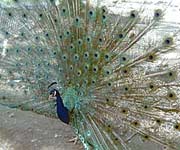 |
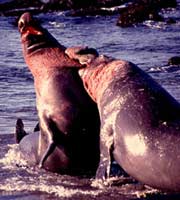 |
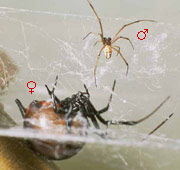 |
 |
Sexual selection is a “special case” of natural selection. Sexual selection acts on an organism’s ability to obtain (often by any means necessary!) or successfully copulate with a mate.
Selection makes many organisms go to extreme lengths for sex: peacocks (top left) maintain elaborate tails, elephant seals (top right) fight over territories, fruit flies perform dances, and some species deliver persuasive gifts. After all, what female Mormon cricket (bottom right) could resist the gift of a juicy sperm-packet? Going to even more extreme lengths, the male redback spider (bottom left) literally flings itself into the jaws of death in order to mate successfully.
Sexual selection is often powerful enough to produce features that are harmful to the individual’s survival. For example, extravagant and colorful tail feathers or fins are likely to attract predators as well as interested members of the opposite sex.
It’s clear why sexual selection is so powerful when you consider what happens to the genes of an individual who lives to a ripe old age but never got to mate: no offspring means no genes in the next generation, which means that all those genes for living to a ripe old age don’t get passed on to anyone! That individual’s fitness is zero.
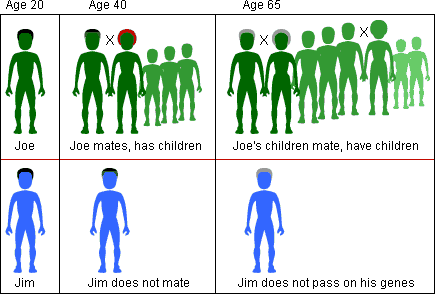
Selection is a two-way street
Sexual selection usually works in two ways, although in some cases we do see sex role reversals:
- Male competition
Males compete for access to females, the amount of time spent mating with females, and even whose sperm gets to fertilize her eggs. For example, male damselflies scrub rival sperm out of the female reproductive tract when mating. - Female choice
Females choose which males to mate with, how long to mate, and even whose sperm will fertilize her eggs. Some females can eject sperm from an undesirable mate.
Artificial selection
Long before Darwin and Wallace, farmers and breeders were using the idea of selection to cause major changes in the features of their plants and animals over the course of decades. Farmers and breeders allowed only the plants and animals with desirable characteristics to reproduce, causing the evolution of farm stock. This process is called artificial selection because people (instead of nature) select which organisms get to reproduce.
As shown below, farmers have cultivated numerous popular crops from the wild mustard, by artificially selecting for certain attributes.
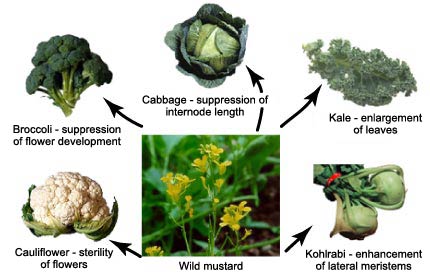
These common vegetables were cultivated from forms of wild mustard. This is evolution through artificial selection.
Adaptation
An adaptation is a feature that is common in a population because it provides some improved function. Adaptations are well fitted to their function and are produced by natural selection.
Adaptations can take many forms: a behavior that allows better evasion of predators, a protein that functions better at body temperature, or an anatomical feature that allows the organism to access a valuable new resource — all of these might be adaptations. Many of the things that impress us most in nature are thought to be adaptations.
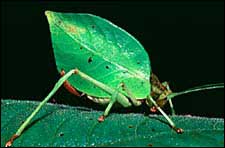 Mimicry of leaves by insects is an adaptation for evading predators. This example is a katydid from Costa Rica.
Mimicry of leaves by insects is an adaptation for evading predators. This example is a katydid from Costa Rica.
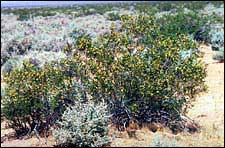 The creosote bush is a desert-dwelling plant that produces toxins that prevent other plants from growing nearby, thus reducing competition for nutrients and water.
The creosote bush is a desert-dwelling plant that produces toxins that prevent other plants from growing nearby, thus reducing competition for nutrients and water.
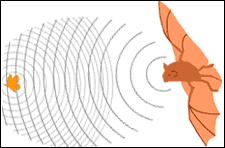 Echolocation in bats is an adaptation for catching insects.
Echolocation in bats is an adaptation for catching insects.
So what’s not an adaptation? The answer: a lot of things. One example is vestigial structures. A vestigial structure is a feature that was an adaptation for the organism’s ancestor, but that evolved to be non-functional because the organism’s environment changed.
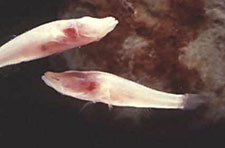 Fish species that live in completely dark caves have vestigial, non-functional eyes. When their sighted ancestors ended up living in caves, there was no longer any natural selection that maintained the function of the fishes’ eyes. So, fish with better sight no longer out-competed fish with worse sight. Today, these fish still have eyes — but they are not functional and are not an adaptation; they are just the by-products of the fishes’ evolutionary history.
Fish species that live in completely dark caves have vestigial, non-functional eyes. When their sighted ancestors ended up living in caves, there was no longer any natural selection that maintained the function of the fishes’ eyes. So, fish with better sight no longer out-competed fish with worse sight. Today, these fish still have eyes — but they are not functional and are not an adaptation; they are just the by-products of the fishes’ evolutionary history.
Misconceptions about natural selection
Because natural selection can produce amazing adaptations, it’s tempting to think of it as an all-powerful force, urging organisms on, constantly pushing them in the direction of progress — but this is not what natural selection is like at all.
First, natural selection is not all-powerful; it does not produce perfection. If your genes are “good enough,” you’ll get some offspring into the next generation — you don’t have to be perfect. This should be pretty clear just by looking at the populations around us: people may have genes for genetic diseases, plants may not have the genes to survive a drought, a predator may not be quite fast enough to catch her prey every time she is hungry. No population or organism is perfectly adapted.
Second, it’s more accurate to think of natural selection as a process rather than as a guiding hand. Natural selection is the simple result of variation, differential reproduction, and heredity — it is mindless and mechanistic. It has no goals; it’s not striving to produce “progress” or a balanced ecosystem.
In fact, biologists have a lot to say about what is and is not an adaptation.


This is why “need,” “try,” and “want” are not very accurate words when it comes to explaining evolution. The population or individual does not “want” or “try” to evolve, and natural selection cannot try to supply what an organism “needs.” Natural selection just selects among whatever variations exist in the population. The result is evolution.
At the opposite end of the scale, natural selection is sometimes interpreted as a random process. This is also a misconception. The genetic variation that occurs in a population because of mutation is random — but selection acts on that variation in a very non-random way: genetic variants that aid survival and reproduction are much more likely to become common than variants that don’t. Natural selection is NOT random!
Attribution
“Mechanisms: the processes of evolution.” Understanding Evolution. University of California Museum of Paleontology. 8 June 2020 <https://evolution.berkeley.edu/evolibrary/article/evo_14>.
“Descent with modification.” Understanding Evolution. University of California Museum of Paleontology. 8 June 2020 <https://evolution.berkeley.edu/evolibrary/article/0_0_0/evo_15>.
“Mechanisms of change.” Understanding Evolution. University of California Museum of Paleontology. 8 June 2020 <https://evolution.berkeley.edu/evolibrary/article/evo_16>.
“Genetic variation.” Understanding Evolution. University of California Museum of Paleontology. 8 June 2020 <https://evolution.berkeley.edu/evolibrary/article/evo_17>.
“Mutations.” Understanding Evolution. University of California Museum of Paleontology. 8 June 2020 <https://evolution.berkeley.edu/evolibrary/article/evo_18>.
“Mutations (2 of 2).” Understanding Evolution. University of California Museum of Paleontology. 8 June 2020 <https://evolution.berkeley.edu/evolibrary/article/evo_19>.
“The causes of mutations.” Understanding Evolution. University of California Museum of Paleontology. 8 June 2020 <https://evolution.berkeley.edu/evolibrary/article/evo_20>.
“Gene flow.” Understanding Evolution. University of California Museum of Paleontology. 8 June 2020 <https://evolution.berkeley.edu/evolibrary/article/evo_21>.
“Sex and genetic shuffling.” Understanding Evolution. University of California Museum of Paleontology. 8 June 2020 <https://evolution.berkeley.edu/evolibrary/article/evo_22>.
“Development.” Understanding Evolution. University of California Museum of Paleontology. 8 June 2020 <https://evolution.berkeley.edu/evolibrary/article/evo_23>.
“Genetic drift.” Understanding Evolution. University of California Museum of Paleontology. 8 June 2020 <https://evolution.berkeley.edu/evolibrary/article/evo_24>.
“Natural selection.” Understanding Evolution. University of California Museum of Paleontology. 8 June 2020 <https://evolution.berkeley.edu/evolibrary/article/evo_25>.
“Natural selection at work.” Understanding Evolution. University of California Museum of Paleontology. 8 June 2020 <https://evolution.berkeley.edu/evolibrary/article/evo_26>.
“What about fitness?.” Understanding Evolution. University of California Museum of Paleontology. 8 June 2020 <https://evolution.berkeley.edu/evolibrary/article/evo_27>.
“Sexual selection.” Understanding Evolution. University of California Museum of Paleontology. 8 June 2020 <https://evolution.berkeley.edu/evolibrary/article/evo_28>.
“Sexual selection. (2 of 2)” Understanding Evolution. University of California Museum of Paleontology. 8 June 2020 <https://evolution.berkeley.edu/evolibrary/article/evo_29>.
“Artificial selection.” Understanding Evolution. University of California Museum of Paleontology. 8 June 2020 <https://evolution.berkeley.edu/evolibrary/article/evo_30>.
“Adaptation.” Understanding Evolution. University of California Museum of Paleontology. 8 June 2020 <https://evolution.berkeley.edu/evolibrary/article/evo_31>.
“Misconceptions about natural selection.” Understanding Evolution. University of California Museum of Paleontology. 8 June 2020 <https://evolution.berkeley.edu/evolibrary/article/evo_32>.

